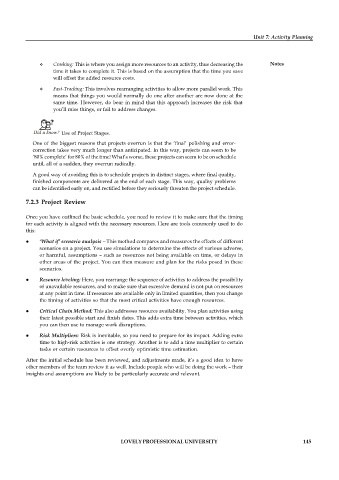Page 151 - DCAP304_DCAP515_SOFTWARE_PROJECT_MANAGEMENT
P. 151
Unit 7: Activity Planning
Crashing: This is where you assign more resources to an activity, thus decreasing the Notes
time it takes to complete it. This is based on the assumption that the time you save
will offset the added resource costs.
Fast-Tracking: This involves rearranging activities to allow more parallel work. This
means that things you would normally do one after another are now done at the
same time. However, do bear in mind that this approach increases the risk that
you’ll miss things, or fail to address changes.
Did u know? Use of Project Stages.
One of the biggest reasons that projects overrun is that the ‘final’ polishing and error-
correction takes very much longer than anticipated. In this way, projects can seem to be
’80% complete’ for 80% of the time! What’s worse, these projects can seem to be on schedule
until, all of a sudden, they overrun radically.
A good way of avoiding this is to schedule projects in distinct stages, where final quality,
finished components are delivered at the end of each stage. This way, quality problems
can be identified early on, and rectified before they seriously threaten the project schedule.
7.2.3 Project Review
Once you have outlined the basic schedule, you need to review it to make sure that the timing
for each activity is aligned with the necessary resources. Here are tools commonly used to do
this:
‘What if’ scenario analysis – This method compares and measures the effects of different
scenarios on a project. You use simulations to determine the effects of various adverse,
or harmful, assumptions – such as resources not being available on time, or delays in
other areas of the project. You can then measure and plan for the risks posed in these
scenarios.
Resource leveling: Here, you rearrange the sequence of activities to address the possibility
of unavailable resources, and to make sure that excessive demand is not put on resources
at any point in time. If resources are available only in limited quantities, then you change
the timing of activities so that the most critical activities have enough resources.
Critical Chain Method: This also addresses resource availability. You plan activities using
their latest possible start and finish dates. This adds extra time between activities, which
you can then use to manage work disruptions.
Risk Multipliers: Risk is inevitable, so you need to prepare for its impact. Adding extra
time to high-risk activities is one strategy. Another is to add a time multiplier to certain
tasks or certain resources to offset overly optimistic time estimation.
After the initial schedule has been reviewed, and adjustments made, it’s a good idea to have
other members of the team review it as well. Include people who will be doing the work – their
insights and assumptions are likely to be particularly accurate and relevant.
LOVELY PROFESSIONAL UNIVERSITY 145

